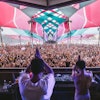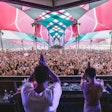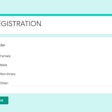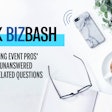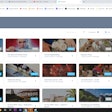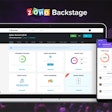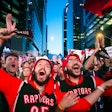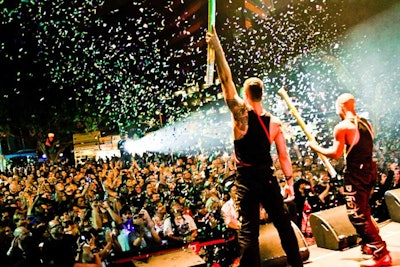
The city of West Hollywood is once again gearing up to welcome L.A. Pride, slated this year for June 10 through 12. Though its founding function was as an L.G.B.T.Q. gathering, the event has evolved into a three-day ticketed music festival with a curated mix of electronic, pop, hip-hop, R&B, and Latin artists, all performing on one of four venue stages. Carly Rae Jepsen will headline the bash now known as L.A. Pride Music Festival & Parade, joining artists such as Charli XCX, Krewella, and 50 other acts. New facets to this year’s program include three days of Latin music and hip-hop programming, a drag revue, and art installations integrated into the festival grounds. Weekend general admission tickets are currently offered at $45, or $125 for V.I.P.
“This year we doubled down on talent and are excited to have such a strong lineup performing at the music festival,” said Chris Classen, the president of Christopher Street West, which produces the event. “Our festival rivals other major music events around the country and offers a lineup you can’t find anywhere else among L.G.B.T.Q. events, and at a fraction of the cost of other music festival tickets.”
With consistent and calculated development of its musical offerings, the event has now become the largest ticketed music festival of any genre in the Los Angeles region—and the largest ticketed L.G.B.T.Q. music festival in the nation. And while the strategy has been successful overall, growth hasn’t happened without some pushback.
Event producer Jeff Consoletti spoke to BizBash about how and why the festival went in this direction—and what happened when some among the loyal attendees didn’t like the changes.
Why did it make sense to expand on the music offerings as an incentive to draw guests?
Music was incorporated as a way to engage and excite the community over a common interest. From its inception, the L.A. Pride Festival has incorporated experiences that not only excite crowds with performances from some of today’s top artists, but also experiences that educate crowds—whether it’s [about] current issues the community is facing or educating the community on our history, art, and nonprofit engagement. L.A. Pride has always been a celebration of the community, recognizing its past struggles but celebrating its uniqueness and diversity.
Not all of the changes were well received. Why and how did you respond quickly?
This year, the organization made a series of changes from programming to shifts in venue locations, ticket pricing, and special events as well as the number of exhibitor spaces offered. Originally, we were going to offer Friday night as a night that combined both free events and paid experiences. In the past, we’ve had a free Friday night program but most of the festival was not in use—we wanted to open up the full festival experience. After communicating with several community organizations, we decided to shift the programming back to a free Friday experience. Part of the issues were signature programs moving locations from previous years within the festival grounds due to talent performances—and some were ticket-price based. We decided to shift some of the talent programming around, decrease the overall single-day ticket pricing, and offer up Friday night as a free experience again. This is an L.G.B.T.Q. community-focused experience; when part of the community started to voice their concerns with the new programming, we took notice and made adjustments accordingly.
How are the performers chosen for the lineup?
First and foremost, ensuring that artists are allies and supporters of the L.G.B.T.Q. community or are openly L.G.B.T.Q. themselves remains a requirement of any performer across our event. No matter how big the artist name, we ensure their participation is because of their allegiance to the L.G.B.T.Q. community. Next, we look to engage a mix of top-level talent and up and comers. Here in Los Angeles, we like to be cutting edge with our talent selections. Who is the next big thing? We set the trend among pride events to ensure our production and talent offering is diverse, eclectic, and speaks to a multi-generational attendee. We encourage submissions by local artists as well who are representative of the local community. In L.A., this still sometimes means some of the best rising young stars.
How many tickets are now sold for the event?
One-third of our tickets are sold in advance of the event. The majority of these sales occur within 10 days of the event. We’ve sold several thousand tickets to date, which is trending higher than last year’s event in which 43,000 tickets were sold. We are on target to once again have record crowds for both the festival and parade in West Hollywood.
How does marketing reflect the combination of pride plus music messaging?
Christopher Street West has the opportunity to engage a large audience with relevant messaging that affects our community, all in a fun casual setting. We have tens of thousands of festival attendees come through the festival gates each day. Through various programs and activations, we’re able to reinforce that year’s messaging. This year’s focus for the organization is on HIV/AIDS amongst our L.G.B.T.Q. members of color, including messaging and activations aimed at education and prevention. L.A. Pride has the opportunity and responsibility to tie in social messaging with our cultural celebration. It’s a great way to engage the community and the public with serious social issues by using music and a festival to drive awareness. In 2014, the organization focused on a TLGBcampaign, which garnered massive coverage and helped shine a light on issues affecting our trans community.
Much of this messaging is reinforced with our social media campaigns, media engagement, and on-site activations. This year’s focus reflects a current epidemic of HIV/AIDS within our communities of color. Combining our marketing campaigns, media engagement, and public engagement through on-site activations and branding, we are able to reach a massive audience with our messaging, and hopefully make a difference in people’s lives.
How is L.A.’s event differentiated from other pride events around the world?
L.A. is unique since it is a city with a global platform. Our Pride event, from our creative execution and production to our talent selections, to our grand marshal and our commitment to the community, is vastly studied and critiqued. As the entertainment capital of the world, we strive to create an event that pushes trendsetting boundaries for events, nightlife, concerts, and festivals. We work with a diverse and collaborative team on bringing unexpected surprises to the event each year—whether pop-up water parks, outdoor roller rinks, or specialty amusements—we try to sprinkle in a little of something for everyone to be as entertaining and celebratory as possible.
While we boast top-notch live musical acts, we also are proud of our commitment to community, showcasing over 50 unique nonprofit exhibitor booths, outreach spaces for youth and transgender communities, and an entire pop-up sober carnival within the event. We carefully curate our food and beverage program that enhances the guests experience of our event—we want our guests not to just come and watch a concert, but to stay, learn, and celebrate with us. This focused approach to guest enhancement has contributed to our year after year staggering growth, [as we've become] one of the most developed, sophisticated, and commended pride events internationally.
